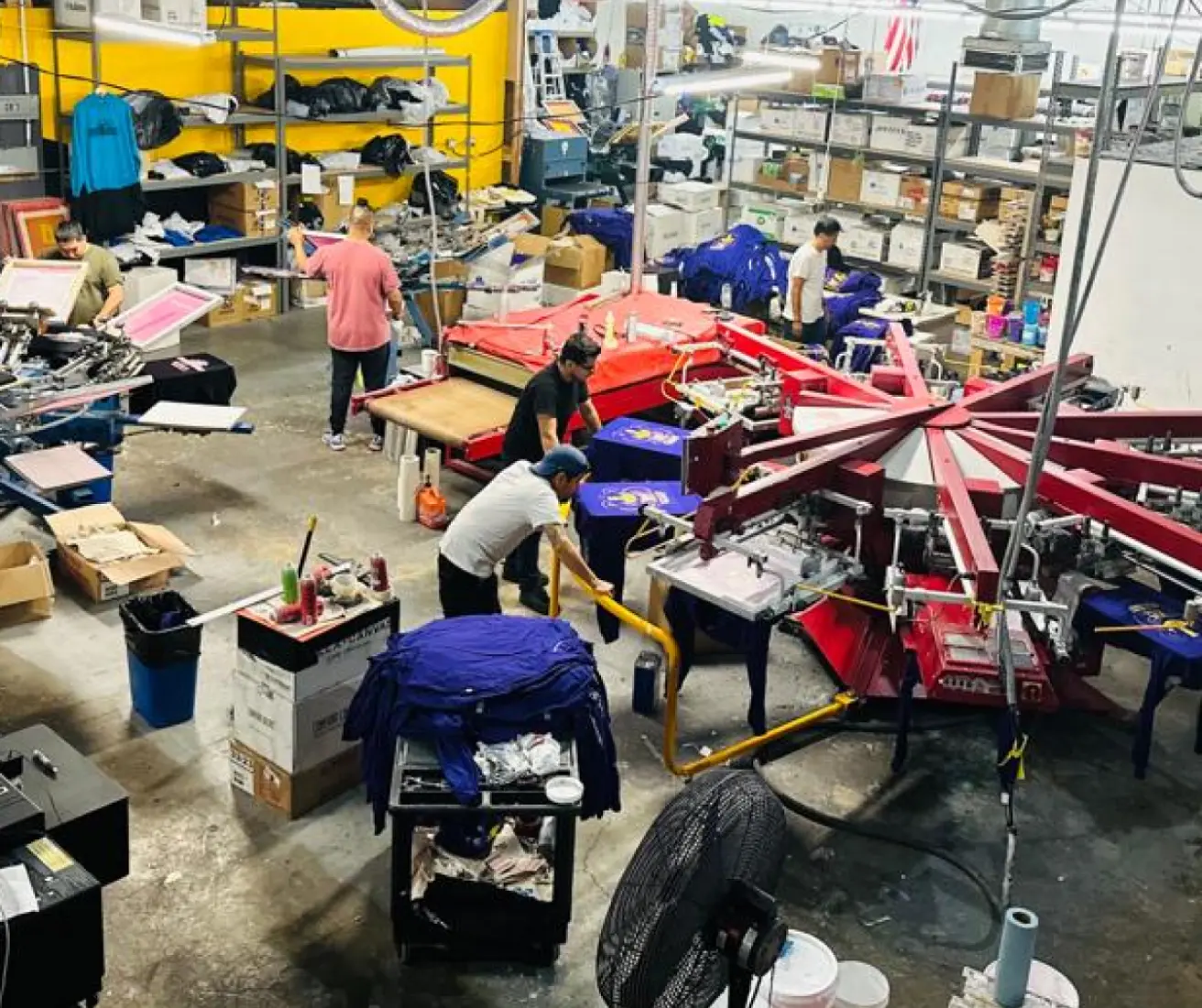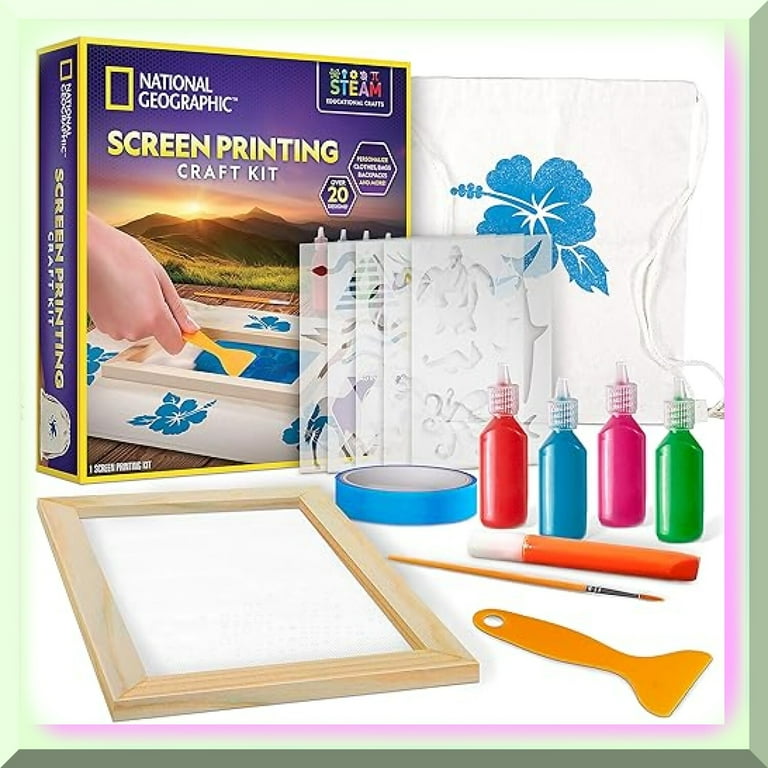Complete Screen Printing Kit for Artists and Creators
Complete Screen Printing Kit for Artists and Creators
Blog Article
Screen Printing Uncovered: Every Little Thing You Need to Learn About T-Shirt and Garment Printing Techniques
If you've ever asked yourself exactly how those vibrant designs end up on your preferred t-shirts, you remain in the right area. Display printing is a remarkable approach that incorporates art with technique, offering endless opportunities for creative thinking. Comprehending the principles, from tools to ink choices, can greatly influence your outcomes. Prepared to explore the vital elements that make display printing an art type? Let's uncover the details that can elevate your projects.
The Basics of Display Printing: How It Works
When you plunge into display printing, you'll find it's both an art and a scientific research. At its core, display printing includes producing a pattern, or display, that permits ink to pass through only in details areas.
Next, you'll mix your inks and prepare your printing surface area. Placement the screen over the material, then use a squeegee to push ink via the screen onto the garment. This process requires precision, as you want clear, dynamic prints. After printing, you'll cure the ink with warm, guaranteeing it follows the textile and lasts through cleans. Each action is crucial, and understanding them will certainly boost your screen printing abilities, changing easy garments into distinct, meaningful items.
Kinds Of Display Printing Methods
As soon as you comprehend the basics of display printing, it's time to explore the various methods that can raise your layouts. One popular method is conventional screen printing, where ink is pushed via a stenciled display.
If you're going for fine information, think about discharge printing. This technique gets rid of dye from the textile, leaving a soft, classic appearance. An additional alternative is plastisol printing, recognized for its longevity and brilliant shades, making it a favored for many brand names. Experiment with halftone printing to develop gradient results and elaborate styles. Each technique has its one-of-a-kind beauty, so do not think twice to attempt them bent on discover what suits your style best!
Vital Tools for Display Printing
To achieve spectacular outcomes in screen printing, having the best tools is basic. You'll need a sturdy display printing framework, which holds the mesh that transfers your layout onto the garment. Next off, spend in top quality squeegees; these are necessary for applying ink evenly throughout the screen. You'll additionally require a good direct exposure system to produce your screens, in addition to a washout cubicle for cleaning them after use. A dependable warm source, like a conveyor dryer or heat press, is important for curing your prints to guarantee long life. Do not neglect an appropriate office, equipped with tables and storage for your materials. Finally, protective gear, such as handwear covers and masks, will maintain you secure from chemicals and inks. With the right devices, you'll be well on your method to producing professional-quality prints.
Picking the Right Inks and Products
When selecting inks and products for screen printing, you need to consider the type of ink that functions ideal for your job. Consider material compatibility to ensure your designs look last and wonderful long. Explore eco-friendly ink options to make your printing process much more lasting.
Types of Screen Inks
Selecting the appropriate display ink is essential for attaining vivid, sturdy prints that meet your job's demands. There are a number of kinds of display inks to check out. Plastisol ink is prominent for its versatility and ease of use, giving exceptional shade opacity on dark materials. Water-based ink, on the other hand, offers a softer feeling and is environment-friendly, making it excellent for those looking to reduce their ecological impact. Discharge inks eliminate color from the fabric, leading to a soft, classic appearance however require specific handling. Specialized inks, such as metallic or glow-in-the-dark, can add one-of-a-kind impacts to your layouts. Examine your task demands and choose the ink that straightens best with your wanted result.

Textile Compatibility Considerations
Understanding material compatibility is vital for accomplishing high-quality screen prints, especially given that various products respond distinctly to different inks. When choosing inks, consider the textile type-- cotton, polyester, or blends. For cotton, water-based inks function well, offering soft qualities and breathability. Polyester, on the various other hand, often calls for plastisol inks for far better attachment and lively colors. If you're publishing on blends, you may need to utilize a combination of both kinds. Always test your inks on sample material to ensure they stick appropriately and maintain color honesty. Furthermore, bear in mind that material weight and structure can affect the final result, so selecting the right ink and product combo is essential for your project's success.
Eco-Friendly Ink Options
Green inks are becoming a prominent choice for display printers who desire to lessen their environmental impact while keeping quality. When read this post here choosing inks, take into consideration water-based inks, which are less dangerous and simpler to cleanse up compared to typical solvents.
Additionally, try to find inks made from renewable energies, such as soy or vegetable-based choices. By picking the right inks and products, you'll not only create sensational styles but likewise contribute to a more lasting printing procedure. Make the switch, and your prints will reflect your dedication to the atmosphere!
Preparing Your Layout for Display Printing

Submit Layout Needs
To ensure your design looks sharp and vivid on fabric, you'll require to pay close focus to submit format requirements for display printing. Make certain your design has a clear history to stop undesirable white edges on your prints. Maintain color modes in mind; CMYK is conventional for screen printing, so transform your RGB designs as necessary.
Shade Splitting Up Strategies
Shade separation is a vital step in preparing your style for screen printing, and mastering it can considerably boost your print quality. You'll need to break your layout right into individual colors, as each shade calls for a different screen during printing. This precision not just guarantees exact color depiction but additionally streamlines the printing process.
Resolution and Dimension
Accomplishing the most effective cause screen printing begins with guaranteeing your layout has the ideal resolution and dimension. Ideally, your artwork ought to go to the very least 300 DPI (dots per inch) for sharp, clear prints. If you utilize lower resolution, your end product might look pixelated and less than professional.
When it pertains to dimension, think about the dimensions of your print area. Design your artwork to match the final print size, ideally producing it in the actual measurements you'll be printing. By doing this, you'll stay clear of any type of unforeseen scaling problems.
Always inspect your style in both vector and click this raster formats. Vector graphics can be scaled without shedding quality, making them optimal for screen printing. Preparing correctly will ensure your style looks fantastic on every garment!
Step-by-Step Display Printing Refine
Screen printing is a dynamic process that permits you to produce dynamic layouts on numerous surface areas. To obtain started, you'll require a screen, solution, and your picked ink.
After rinsing the unexposed solution, your screen is ready. Set it up on your printing surface area and straighten your garment beneath it. Pour ink onto the screen and use a squeegee to push the ink via the stencil onto the textile. Raise the screen meticulously and let the print dry. Heal the ink using warm to ensure sturdiness. That's it! You have actually successfully screen published your style.
Tips for Successful Display Printing Projects
While you're diving right into your display printing jobs, bear in mind that prep work is crucial to success. Beginning by collecting all your materials-- inks, displays, squeegees, and garments. A tidy workspace assists avoid undesirable mistakes, so clean prior to you start.
Following, verify your art work is high-resolution and effectively sized for your garment. Evaluate your display for correct direct exposure and tidy it thoroughly to prevent spots. When blending your inks, follow the producer's guidelines to attain the ideal uniformity.
Throughout printing, use even stress with your squeegee for regular outcomes. Do not rush; take your time to confirm each print fulfills your requirements. After printing, allow your garments completely dry totally custom screen printing before managing or packaging them.
Last but not least, constantly keep an example of your benefit future reference. In this manner, you can assess your progression and improve your methods with time. Delighted printing!

Often Asked Concerns
How much time Does It Require To Set up a Screen Printing Work?
Establishing a display printing task typically takes about thirty minutes to an hour. You'll prepare the screens, mix inks, and adjust the press. The moment differs based upon intricacy and experience, so stay organized!
Can I Print on Different Fabric Enters Making Use Of the Same Method?
Yes, you can print on various material kinds using the same technique, yet you'll need to change your inks and setups. Some materials absorb ink in a different way, so trying out assurances the very best outcomes for each material.
What Prevail Blunders to Avoid in Display Printing?
When display printing, prevent common mistakes like using the incorrect ink, disregarding appropriate direct exposure times, or avoiding pre-press checks. Constantly evaluate your configuration and keep clean displays to assure top quality outcomes each time.
Just How Can I Appropriately Tidy and Preserve My Screen Printing Equipment?
To effectively tidy and maintain your display printing tools, you should frequently clean screens with appropriate solvents, examine squeegees for wear, and ensure all tools are stored dust-free and completely dry. Uniformity enhances and protects against costly repairs efficiency.
Is Display Printing Eco-friendly Contrasted to Various Other Techniques?
Display printing can be much more ecologically pleasant than various other approaches, particularly if you make use of eco-conscious products and water-based inks. By selecting lasting products and practices, you decrease waste and decrease your influence on the earth.
Screen Printing Uncovered: Whatever You Required to Know Regarding Tee Shirt and Garment Printing Methods
At its core, display printing includes developing a stencil, or screen, that permits ink to pass with just in certain areas. Placement the screen over the fabric, then make use of a squeegee to press ink via the screen onto the garment. One preferred approach is standard screen printing, where ink is pushed via a stenciled screen.When choosing inks and products for screen printing, you need to take right into account the kind of ink that works finest for your task.
Report this page